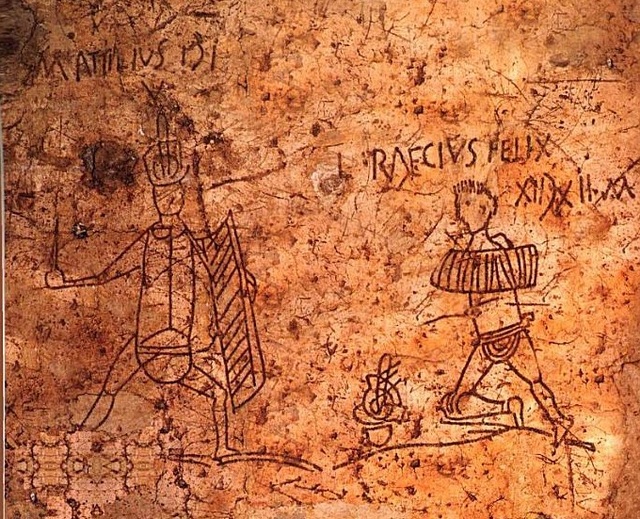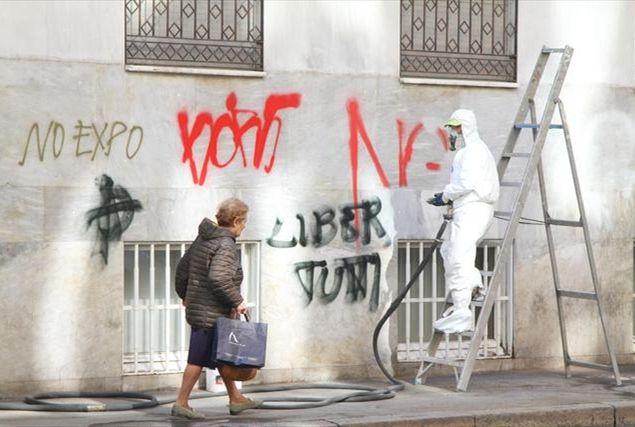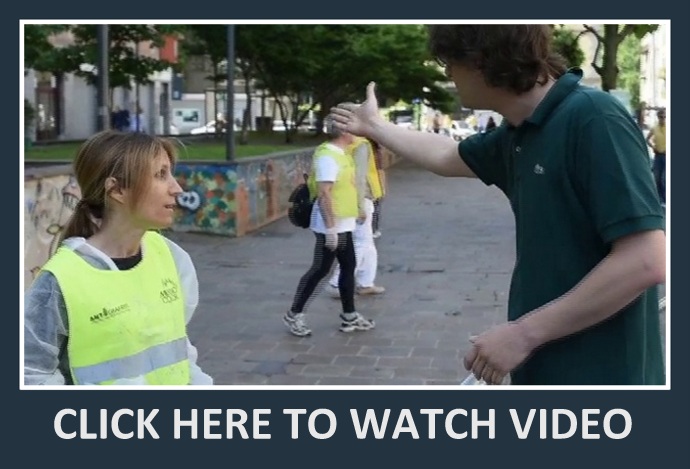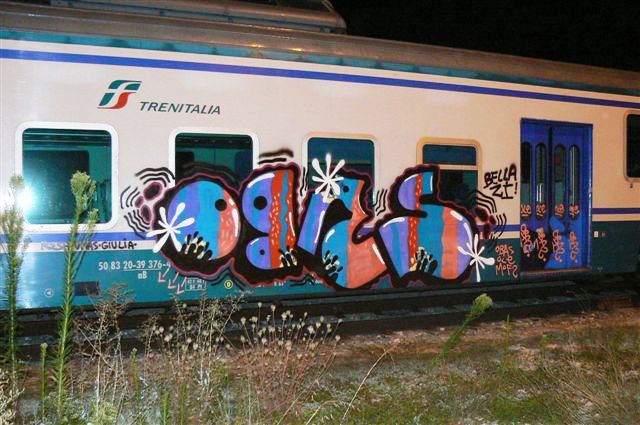Is it Art? Posted by Geoff on May 19, 2015 in Culture, News
Does anyone really know what art is any more?
Artists have always pushed the boundaries, posed difficult questions and challenged our preconception. Perhaps it was always inevitable therefore that the line that divides what we considered to be art from ‘everything else’ would eventually blur and fade. One particular genre that has caused much pondering on the topic of ‘is it art?’ is that of graffiti.
The word graffiti, as you might guess, has its origins in the Italian word graffiato (scratched). The technical term graffiti was originally used to refer to the inscriptions, and drawings found on the walls of ancient sepulchres or ruins, but more recently the term has come to define graphics illicitly applied to a surface, and is closely linked to the word vandalism.
But what is Geoff doing pondering on such philosophical matters early on a Monday morning? Well, a news article about a recent graffiti related incident got me thinking … yes, it’s bad habit of mine that I’m trying to give up! The incident described in the article took place during the massive clean up operation necessitated by the mindless destruction inflicted on Milano by members of the Black Bloc during the NO EXPO protests
An abbreviated version of the article from Il Corriere della Sera:
In piazza Santissima Trinità, non lontano dal Parco Sempione, sabato mattina le squadre di «Bella Milano», impegnate nella pulizia della città, hanno cancellato parte del murale di Pao, alias Paolo Bordino, nell’area giochi. I primi a protestare sono stati gli abitanti del quartiere: “Ai nostri figli quelle immagini piacciono, per loro sono un segno distintivo, familiare, chi vi ha dato il permesso?”.
L’intervento di ieri (sabato 16 aprile) dei volontari di Retake Milano (Associazione Nazionale Antigraffiti per il Decoro Urbano), è stato quanto meno avventato, certo il murale era scolorito, con qualche pasticcio sopra, ma è evidente che per molti era ancora preferibile al noiosissimo rosa pallido che hanno scelto.
Non era meglio prima parlare con i residenti? E magari contattare chi quel muro aveva dipinto, se pur senza permesso ufficiale, con il consenso dei fruitori di quello spazio?
In the artist’s words:
“Nel 2001 dipinsi assieme a Linda il muro di via Cesariano. Uno dei miei primi muri, realizzato con il consenso dei frequentatori della piazza, genitori, abitanti, negozianti. Ottenere il permesso da parte del Comune era operazione impossibile, quindi decidemmo di fare quello che ritenevamo giusto, andando oltre agli ostacoli burocratici. A volte, seguire la propria coscienza è la cosa giusta da fare, a volte il bello dell’arte è proprio questo.
Raccogliemmo i soldi per i colori, coinvolgemmo i bambini, facendoci aiutare da loro per colorare, chiudemmo l’esperienza con una bella festa di inaugurazione. Un vigile passò di lì e in quanto dotato di buon senso, ci disse di continuare, che lui non aveva visto niente… Da allora, il muro ha caratterizzato un parchetto altrimenti anonimo regalandogli un’anima. Seppure non si tratta del muro più bello che io abbia realizzato rimane uno dei più sentiti, proprio per la sua funzione sociale”
The following video captures part of the argument that took place between local residents and the volunteers of Retake Milano.
My thoughts on the matter:
I began this article by asking myself: “Does anyone really know what art is any more?” I guess that question was prompted by the actions of the volunteers who indiscriminately obliterated any form of graffiti they happened upon, and seemed unable to distinguish between pure vandalism and street art.
Most of us, of course, have our own ideas about what constitutes art. My personal answer to the question ‘what is art’ would be: art is simply a vague generic category that we put certain things into. Those things are not fixed but change according to contemporary interpretations of ourselves and our environment. It’s an endless debate in which I engaged many times as an art student and teacher, but there really is no way of escaping the fact that: ‘Non è bello ciò che è bello ma è bello ciò che piace’, or as we say in English, ‘Beauty is in the eye of the beholder’.
However, philosophical discussion about the nature of art aside, what strikes me most about this whole affair is that behind this story lies something fundamentally familiar and distinctly Italian which I can summarise as follows:
-
lack of communication between authorities and citizens, or between any of the innumerable citizen formed ‘associations’
- spontaneous decisions that are frequently made to undertake big projects with very little forethought or planning
- overcomplicated and long winded bureaucracy that constrains people to sort things out for themselves
- willingness by authorities to ‘turn a blind eye’ in certain cases, with later negative repercussions
In fact, I’ve seen far too many well intentioned projects go wrong here in Italy due to the above factors, and to be honest, I can’t see things changing any time soon. However, on a positive note, the council have offered an apology and promised to get their act together by actually releasing official permission for the project (meglio tardi che mai!). What’s more, the artist Pao has offered to repaint the murals.
Here’s another interesting article in which Pao talks about his graffiti and expresses his opinion on its destruction.
Your thoughts on the matter?:
I’d love to hear them, so please leave a comment!

Build vocabulary, practice pronunciation, and more with Transparent Language Online. Available anytime, anywhere, on any device.








Comments:
Allan Mahnke:
You have hit upon a favorite topic. Oh, the hours I have spent staring at the illustrations of graffiti from Pompeii in the ponderous Corpus Inscriptionum Latinarum, “popularly” known among friends as CIL! Many graffiti are so interesting. They a wonderful insight on life nearly 2000 years ago. (Some are admittedly a little ordinary.) Generally, modern graffiti, especially like that of the Black Bloc and similar groups, seem so uninspired compared to the ancient stuff. That, however, is probably my opinion alone.
Geoff:
@Allan Mahnke It certainly is a fascinating topic. In fact I struggled a bit trying to fit it into such a short article as there was so much else I would have liked to have said.
Regarding the value of modern graffiti, here’s an interesting quote that I came across when I was researching my article:
“When archaeologist John Schofield compared contemporary graffiti to prehistoric cave art, there was uproar. But what is the difference? Both are forms of expression by people writing or creating art on a public surface. The only real difference is time.”
Here’s an interesting article about modern graffiti as archaeology: http://archive.archaeology.org/0707/etc/graffiti.html
Saluti da Geoff
Transparent Language:
Comment via email:
Leggo sempre Italian Language Blog e questo e molto interessante come sempre e poi ho imparato che ci siano tante definizioni della parola ‘cancellare’!
(Non riesco mandare un commento sotto, cosi ti mando una risposta via email.)
Auguri,
Lesley (dalla Nuova Zelanda)
Transparent Language:
Comment via email:
Good question. As they say.
And before I clear the whole matter up let me first thank you for your very excellent blog. At present my Italian lets me be fed, watered, transported and directed when in that beguiling country. I hope to move on from that level.
To Art.
If it does not enhance life, it is not Art.
Simple. Enhance I Hear you ask. Well try ► verb[with obj.] intensify, increase, or further improve the quality, value, or extent of: as the Oxford English Dictionary defines it.Does it make you: smile, think, improve the surroundings, etc.And as humanity thinks, acts, etc on a bell curve you can bet good money that we mostly agree on what has been enhanced and what has not. That is why most of what is described as graffiti is just vandalism. Banksy can draw, and draw well. So at least there at least is the potential for a positive,enhancing, outcome .
I could go on. I am sure you have that feeling by now ?But I won’t. I am glad to have cleared this conundrum up for you.On a more prosaic note. Can you suggest any reading for me that will help,improve my Italian. I self judge my linguistic ability as ” Tourist Level 2″Many Thanks,
David
Transparent Language:
Comment via email:
I just want to thank you for your blog on the Santa Maria Novella church in Florence. I was in Florence last week and made a point of visiting it. What a gem! and such a peaceful sanctuary after the bustle of the city and the jostle of sightseers around the main squares. I very much doubt whether I would have found it out had I not picked up on your obvious love for it. Thank you.
Val
Transparent Language:
Comment via email:
Hi Geoff/Serena,
I really enjoyed the graffiti article. Thank you.
I saw this last year in Bologna, that most political of University towns. It reads “No more lager in my life”, and I reckon that there are two possible explanations for its appearance.
Either it was a call to arms to stop the University bars serving non-Italian beers, or it was painted under the influence of a really bad hangover!
Whatever the motive, it provided a bit of light relief from Bologna’s spectacular quantity of graffiti with a “workers unite” or “resist austerity” theme!
dg
paolo:
L’arte, Dio e l’amore: tre cose di cui è meglio non parlare. (e se possibile, la politica)
Ma se sì, forse sarebbe meglio parlare di quello che NON è l’arte, Dio oppure l’amore, possibilmente con il risultato di trovare qualche significato personale,
oppure forse l’arte è qualsiasi cosa fatto bene
oppure forse secondo Andy Warhol “Art is a boy’s name.” (il mio preferito)